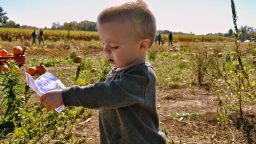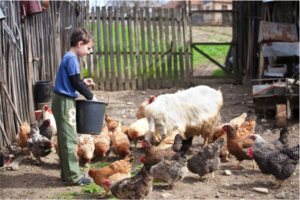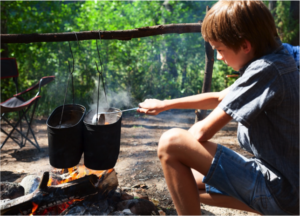When I was a kid, to play out in nature for hours on end wasn’t just a privilege–it was my natural inclination! Over just a few short decades, we’ve domesticated our kids and planted them firmly in front of glowing screens and in school desks, and we wonder why so many problems crop up. For the cooped-up kid, a day outside is the best medicine. Here’s a great little project to turn a small patch of land into a seasonal, living, and edible playhouse, and it’s even easy enough for your children to help you build it!
The Runner Bean Teepee
What You Need:
1) 8 – 10 long bamboo canes (6 to 7 feet minimum, all the same length).
2) Gardening twine or zip ties.
3) A packet or two of runner bean seeds.
4) A large spool of gardening twine or a roll of chicken wire (optional).
How to Build It:
1) Choose a spare area of garden, either on a border, or on the lawn. Choose a spot where you’ll be okay with the kids playing.
2) To create the circular frame of your teepee, push the bamboo canes into the ground, starting with four equidistant canes and filling in the spaces between. Leave a large gap between two of the canes for an entrance. Secure the tops of the canes together using the twine or zip ties. At this point, it should look like the frame to a teepee.
3) For best results, reinforce the teepee frame with either chicken wire, or a network of gardening string.
4) Dig one square foot (12″ by 12″ and 12″ deep) around the base of each bamboo cane.
5) Add compost, aged manure, or seed-starting soil.
5) Sow two runner bean seeds approximately 1 to 2″ deep at the base of each cane.
6) As you sow each seed, fill the hole with water. Once the water has drained, gently cover the hole with soil and water once more. Depending on your climate, you may also start your runner beans early in 3″ pots and transplant when they reach about 6″ tall.
7) The bean plants should find and cling to the bamboo naturally. If they don’t, you can carefully wrap the main shoots around the first part of the bamboo canes or chicken wire until they start to climb on their own.
8) Keep weeds down and moisture in using grass clippings or bark chips around the young runner bean plants. Water frequently. You may start to see slugs preying on your seedlings–no matter! Remove the slugs every evening until the bean plants are about 6″ tall. Once the plants start producing, harvest the beans regularly to encourage growth!
Now you and your children can watch as the beans quickly grow and cover the frame to create a living playhouse! Your kids will love the “job” of harvesting their own beans, and the satisfaction of having built something so fun! Start growing early in spring, and this playhouse will last ‘til the end of summer.
If you enjoyed this, you might also like….
How to Lock Down Your Homestead…
The Ultimate Guide to Natural Health…
Effective Primal Diet Hacks…



 kids should be a part of caring for your family homestead. If you have younger children, there are still plenty of ways that they can help out around the farm.
kids should be a part of caring for your family homestead. If you have younger children, there are still plenty of ways that they can help out around the farm.


